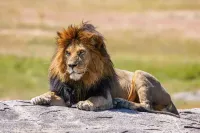The Cincinnati Zoo & Botanical Garden, established in 1873 and opened in 1875, is the second oldest zoo in the United States. Located in Cincinnati's Avondale neighborhood, it started with 64.5 acres and has expanded into surrounding areas and suburban reserves. Recognized for its historical significance, several buildings were designated a National Historic Landmark in 1987.
1901: Cincinnati Traction Company Purchase
In 1901, the Cincinnati Traction Company purchased the Cincinnati Zoo, intending to use it for marketing purposes.
1902: Elephant House Construction
In 1902, the Elephant House was constructed at the Cincinnati Zoo.
1906: Herbivora Building Construction
In 1906, the Herbivora building was constructed at the Cincinnati Zoo for $50,000, housing elephants, giraffes, hippopotamuses, and rhinoceroses.
1910: Death of Martha's mate
On July 10th, 1910, Martha's mate died, making her the sole passenger pigeon of the zoo and the last known individual of her species.
1912: Relocation of Kemper Log Cabin
In 1912, the Kemper Log Cabin, originally built in 1804, was moved to the Cincinnati Zoo.
1914: Death of Martha
On September 1st, 1914, Martha, the last passenger pigeon, died of natural causes at the Cincinnati Zoo, leading to the declaration of the species' extinction.
1916: Advocacy for City Purchase
In 1916, Ohio state senator Robert J. O'Brien advocated for the city to purchase the Cincinnati Zoo.
1917: Cincinnati Zoological Park Association Takes Over
In 1917, the Cincinnati Zoological Park Association, funded by donations, took over the management of the zoo.
1917: Lady Jane dies
In the Summer of 1917, Lady Jane, the mate of Incas the Carolina parakeet, died. This event led to Incas becoming very depressed and mournful.
1920: Start of Cincinnati Opera Summer Festival
From 1920, the Cincinnati Zoo was home to the Cincinnati Opera Summer Festival.
1920: Cincinnati Summer Opera Performances Begin
In 1920, the Cincinnati Summer Opera began performing in an open-air pavilion at the zoo.
1922: Expansion of Reptile House
In 1922, the Reptile House, originally built as the Monkey House, was expanded by constructing a veterinary hospital.
August 1929: Susie Transported to United States
In August 1929, Susie, a female eastern gorilla, was transported from Europe to the United States aboard the Graf Zeppelin.
1931: Susie Loaned to Zoo
In 1931, Robert J. Sullivan permanently loaned Susie, a female eastern gorilla, to the Cincinnati Zoo.
1932: City Purchase
In 1932, the city of Cincinnati purchased the zoo and began running it through the Board of Park Commissioners.
1935: Creation of African Veldt
In 1935, the African Veldt exhibit was built at Cincinnati Zoo with large hoofed animals.
August 7, 1936: Susie's Birthday
On August 7, 1936, more than 16,000 visitors flocked to the zoo to celebrate Susie's birthday, reflecting her popularity.
October 29, 1947: Susie's Death
Susie died on October 29, 1947, and her body was donated to the University of Cincinnati.
1951: Reptiles Introduced
In 1951, the Cincinnati Zoo arranged for an extensive remodeling of the Reptile House, formerly the Monkey House, to prepare it for reptiles.
1951: Reptile House Designation
In 1951, the Reptile House started housing reptiles, changing its purpose from housing monkeys and primates.
1952: Carnivora Building Construction
In 1952, the Cincinnati Zoo's Carnivora Building was built.
1962: Baboon Island Built
In 1962, Baboon Island was built as an open-aired exhibit, it was later renovated and renamed Ibex Island
1970: Flight Cage Opening
In 1970, the Cincinnati Zoo opened one of the largest flight cages of its time.
1971: End of Cincinnati Opera Summer Festival
Until 1971, the Cincinnati Zoo was home to the Cincinnati Opera Summer Festival.
1972: Completion of Gibbon Islands
In 1972, the Cincinnati Zoo completed the Gibbon Islands exhibit, which occupies the former location of the old Opera Pavilion.
1974: Susie's Skeleton Destroyed
In 1974, Susie's skeleton, which had been on display at the University of Cincinnati, was destroyed in a fire.
1975: Listing on National Register
In 1975, four Cincinnati Zoo buildings were listed on the National Register as the "Cincinnati Zoo District".
1975: Big Cat Canyon Opening
In 1975, the Cincinnati Zoo opened Big Cat Canyon, featuring three one-year-old white tigers.
1978: Gorilla World Opening
In 1978, Cincinnati Zoo's Gorilla World exhibit opened as a naturalistic rain forest habitat for western lowland gorillas.
1978: World of the Insect Opening
In 1978, the Cincinnati Zoo opened the World of the Insect building.
1979: Exhibit Award
In 1979, the Cincinnati Zoo received the American Zoo and Aquarium Association exhibit award for World of the Insect.
January 1982: Relocation of Kemper Log Cabin
In January 1982, the Kemper Log Cabin was moved to Sharon Woods Village in Sharonville from the Cincinnati Zoo.
1984: Renovation Start
In 1984, the Cincinnati Zoo began renovations of 55,000 sq ft of exhibits that feature common barnyard animals, animals of the eastern American woodlands, and animals of the southwest American desert.
1985: Carnivora Building becomes Cat House
In 1985, the Carnivora Building at the Cincinnati Zoo was renovated and became the Cat House.
1985: Renovation Completion
In 1985, the Cincinnati Zoo completed renovations of 55,000 sq ft of exhibits that feature common barnyard animals, animals of the eastern American woodlands, and animals of the southwest American desert.
1985: Opening of naturalistic woodland landscape
In 1985, the Cincinnati Zoo opened a naturalistic woodland landscape with native Chinese plant species, simulating the natural habitat of the red panda.
1986: Establishment of CREW
In 1986, the Cincinnati Zoo established the Carl H. Lindner Jr. Family Center for Conservation and Research of Endangered Wildlife (CREW).
1987: National Historic Landmark Designation
In 1987, parts of the Cincinnati Zoo were designated as a National Historic Landmark, named the Cincinnati Zoo Historic Structures.
August 1988: Arrival of White Lion Cubs
In August 1988, the Cincinnati Zoo acquired rare white lion cubs donated by Siegfried and Roy.
1989: Classroom Renovation
In 1989, the classroom used for live animal demonstrations at Cincinnati Zoo was renovated.
1993: Loss of Last Aye-aye
In 1993, the Cincinnati Zoo lost its last aye-aye.
1994: AZA prestigious exhibit award
In 1994, a year after it opened, the attraction received the AZA prestigious exhibit award.
1995: Record Gorilla Births
In 1995, Cincinnati Zoo had a record of 6 gorilla births in one year, and one gorilla gave birth to the world's first test-tube gorilla.
1997: Rhino Reserve Renovation
In 1997, the Cincinnati Zoo's African Veldt was renovated to become Rhino Reserve.
1998: Last Elephant Birth
In 1998, the Cincinnati Zoo had their last successful Asian elephant birth.
May 21, 1999: Manatee Springs Opening
On May 21, 1999, the Manatee Springs attraction opened at the Cincinnati Zoo.
1999: Removal from National Register
In 1999, the Cincinnati Zoo District was removed from the National Register.
2000: Opening of Lords of the Arctic
In 2000, Lords of the Arctic opened at the Cincinnati Zoo, housing species representing northern parts of the world.
2000: Awards for Manatee Springs
In 2000, Manatee Springs at the Cincinnati Zoo was awarded the Munson Aquatic Conservation Exhibitry Award and a Significant Achievement Exhibit Award.
2000: Herbivora Building becomes Vanishing Giants
In 2000, the Herbivora Building became the Vanishing Giants attraction, featuring giraffes, okapis, and elephants.
April 2001: White Lion Cubs Birth
In April 2001, the white lions at the Cincinnati Zoo successfully bred four offspring.
2005: Opening of Wolf Woods
In 2005, Wolf Woods opened at the Cincinnati Zoo after a renovation of Otter Creek.
2007: Renovation of Giraffe and Okapi Yards
From 2007 to 2008, the giraffe and okapi yards were renovated into a food court area, and the animals were moved to other areas.
June 6, 2008: Opening of Dobsa Giraffe Ridge
On June 6, 2008, the $1.6 million Dobsa Giraffe Ridge opened at the Cincinnati Zoo, allowing guests to feed Masai giraffes from an elevated platform.
2008: Renovation of Giraffe and Okapi Yards
From 2007 to 2008, the giraffe and okapi yards were renovated into a food court area, and the animals were moved to other areas.
2009: Komodo Dragon Exhibit Renovation
In 2009, the Komodo dragon exhibit at the Cincinnati Zoo was renovated.
June 2010: Komodo Dragon Exhibit Reopening
In June 2010, the renovated Komodo dragon exhibit at the Cincinnati Zoo reopened.
2010: Renovation to Night Hunters Exhibit
From 2010 to 2011, the Cat House was renovated into the Night Hunters exhibit at the Cincinnati Zoo.
2010: Completion of Phases I and II of the Africa exhibit
In 2010, Phases I and II of the Cincinnati Zoo's eight-acre Africa exhibit were completed, adding an exhibit for cranes and expanding the Cheetah Encounter yard.
2011: Renovation to Night Hunters Exhibit
From 2010 to 2011, the Cat House was renovated into the Night Hunters exhibit at the Cincinnati Zoo.
2011: Acquisition of New Aye-aye
In 2011, the Cincinnati Zoo acquired another aye-aye, a six-year-old transferred from the Duke Lemur Center in North Carolina.
2011: Renovation of Wolf Woods
In the summer of 2011, the Cincinnati Zoo completed another renovation of Wolf Woods, focusing on the conservation story of the Mexican gray wolf.
June 29, 2013: Opening of Phase III of the Africa exhibit
On June 29, 2013, Phase III of the Cincinnati Zoo's Africa exhibit opened, offering visitors an opportunity to see African lions, servals, a bat-eared fox, African wild dogs, and a new cheetah exhibit. The new Base Camp Café was also added.
June 28, 2014: Opening of Phase IV of the Africa expansion
On June 28, 2014, Phase IV, the largest phase of the Africa expansion at the Cincinnati Zoo, opened. It introduced a wide savanna with various bird and mammal species.
2014: Zoo Ranking by USA Today
In 2014, USA Today ranked the Cincinnati Zoo among the best zoos in the country, based on data from the Association of Zoos and Aquariums.
2015: Last Gorilla Birth
In 2015, Elle was the last gorilla born at the Cincinnati Zoo.
2015: Breeding Recommendation for Faru and Seyia
In 2015, the AZA and Species Survival Plan (SSP) determined that parents Utenzi (known in Cincinnati as Faru) and Seyia were a good genetic match and recommended that they breed.
May 28, 2016: Harambe Shot
On May 28, 2016, Harambe, a gorilla, was fatally shot by zoo officials after a child entered his enclosure.
July 23, 2016: Opening of Hippo Cove
On July 23, 2016, Phase V of the Africa expansion opened at the Cincinnati Zoo, adding an area for Nile hippos called Hippo Cove.
January 2017: Fiona's Birth
In January 2017, the Cincinnati Zoo celebrated the first hippopotamus birth in 75 years with the arrival of Fiona, born six weeks prematurely.
January 24, 2017: Birth of premature hippo calf
On the morning of January 24, 2017, Bibi gave birth to a six-weeks premature calf at the Cincinnati Zoo.
July 17, 2017: Birth of black rhino calf, Kendi
On July 17, 2017, a black rhino calf named Kendi was born to parents Faru and Seyia at the Cincinnati Zoo. Kendi was the fifth eastern black rhino born in North America in the past two years. Her birth was captured on camera and available on the zoo's website.
2017: Internet celebrity Fiona
In 2017, the story of Fiona, the premature hippo calf born at the Cincinnati Zoo, made her an internet celebrity and city hero.
June 2018: Harry and Linda Fath Contribution
In June 2018, philanthropists Harry and Linda Fath contributed $50 million to the Cincinnati Zoo's "More Home to Roam" campaign.
2018: Launch of "More Home to Roam" Campaign
In 2018, the Cincinnati Zoo launched an expansion campaign named "More Home to Roam" with the goal of raising $150 million.
2019: Cincinnati Zoo named top zoo in North America
In 2019, the Cincinnati Zoo was named the top zoo in North America by USA Today's reader's choice ranking.
2019: Kendi sent to San Diego Zoo Safari Park
In October of 2019, Kendi was sent to San Diego Zoo Safari Park.
August 2020: Birth of Ajani Joe
In August 2020, Faru and Seyia's second calf, a male named Ajani Joe, was born at the Cincinnati Zoo.
August 2020: Roo Valley Opening
In August 2020, the Cincinnati Zoo finished the first part of their master plan "More Home To Roam" and turned their old Wildlife Canyon exhibit into Roo Valley.
September 2020: Completion of Penguin Habitat Expansion
In September 2020, the Cincinnati Zoo finished the second part of the master plan, expanding the African penguin habitat.
2020: Opening of Roo Valley and African Penguin Point
In the summer of 2020, the Cincinnati Zoo opened Roo Valley and African Penguin Point.
2020: Birth of Penguin Chicks
On January 6 and 7, 2020, the Cincinnati Zoo celebrated the birth of its first babies of the year, with two penguin chicks hatching, one each day.
June 15, 2021: Groundbreaking for Elephant Trek
On June 15, 2021, the Cincinnati Zoo broke ground on the Harry and Linda Fath Elephant Trek.
September 6, 2021: Tucker joins the zoo
On September 6, 2021, a 19-year-old male hippo named Tucker from the San Francisco Zoo joined the Cincinnati Zoo.
2021: Death of the last polar bear
In 2021, the last polar bear at the Cincinnati Zoo's Lords of the Arctic exhibit died.
2021: Euthanization of polar bear
The Cincinnati Zoo euthanized Little One, their last polar bear, due to a renal failure in March of 2021.
May 2022: Death of White Lions
As of May 2022, all the white lions at the Cincinnati Zoo had died, and their exhibit temporarily contained Bennett's wallabies.
August 24, 2022: Birth of hippo calf Fritz
On August 24, 2022, Bibi gave birth to another calf at the Cincinnati Zoo, named Fritz.
September 2022: Faru Moved to Lincoln Park Zoo
In September 2022, Faru/Utenzi was moved from the Cincinnati Zoo to the Lincoln Park Zoo.
2023: Hopeful Opening of Rhino Reserve Renovations and Parking Garage
The Cincinnati Zoo hoped Rhino Reserve renovations and a 1,800 vehicle parking garage would be open by 2023.
2024: Estimated value of reward for another passenger pigeon
In 2024, the $1,000 reward for a successful capture of another living individual would be worth $33,000.
2024: Elephants moved to Elephant Trek
On October 1st, 2024, the elephants at Cincinnati Zoo were moved to the Elephant Trek exhibit.
2025: Retooling of Lords of the Arctic
According to the zoo's master plan, in 2025, the Lords of the Arctic exhibit will be retooled to house North American wildlife, including American black bears and sea otters.
2025: Phase 2 Plans
In 2025, phase 2 will include Siamang’s Point, a rhinoceros hornbill exhibit, Asian small-clawed otters and Babirusa pigs for the Clawed River Otter Habitat and the New Picnic Shelter Complex.
2025: Planned Transfer of Rhinos
In 2025, the Cincinnati Zoo's two current rhinos, Seyia and A.J, are planned to be transferred out.
Mentioned in this timeline
The United States of America is a federal republic located...
California is a U S state on the Pacific Coast...

The lion Panthera leo is a large cat species native...

San Francisco is a major commercial financial and cultural hub...
The National Broadcasting Company NBC is a major American commercial...
Africa is the second-largest and second-most populous continent comprising of...
Trending

1 day ago Olivia Munn Suffered Food Poisoning After Eating Sushi in Bathtub, Vomited at Airport
2 months ago Micron's surge in 2025: Morgan Stanley predicts even greater gains; Cramer bullish.

2 days ago Jeff Goldblum adopts vegetarian diet after 'Wicked' role, citing significant personal change.
6 minutes ago Thanksgiving Dinner Cost Declines: Turkey Prices Lower Across the US

1 hour ago Gary Sinise Foundation gifts milestone 100th home to wounded veteran in Tennessee.

Lily Allen is an English singer songwriter and actress known for her outspoken lyrics and pop music She gained prominence...
Popular

XXXTentacion born Jahseh Dwayne Ricardo Onfroy was a controversial yet...

Cristiano Ronaldo often nicknamed CR is a Portuguese professional footballer...

William Franklin Graham III commonly known as Franklin Graham is...

Candace Owens is an American conservative political commentator and author...

Michelle Obama is an American attorney author and former First...

Bill Clinton the nd U S President - served as...